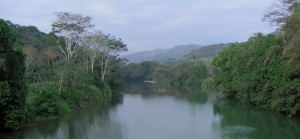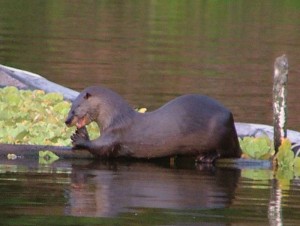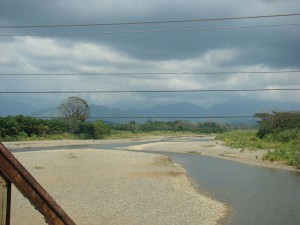Defending an Old Friend?

by Jack Ewing
Back in the 1970s Diane and the kids and I lived in the casona, the old Hacienda Baru home. We didn’t get around to digging a well until the early 1980s, and every year, the free flowing spring that supplied our water would dry up in mid February. To deal with the situation we carried drinking water in 5 gallon plastic containers from another spring two kilometers away and water for washing dishes and flushing toilets in 55 gallon drums. The girl who worked for us went to the Barú River to do laundry, and every afternoon around 4:00 PM everyone went to the river to bathe in the crystal clear water. The village of Dominical was out of water too, so most of the town – about 8 people at that time — met us there, and the afternoon bath became as much a social event as one of personal hygiene.
Another daily visitor to the bathing ritual was the Neotropical River Otter (Lutra longicaudis.) No sooner did we started splashing around than a couple of otters would appear from down river, swimming toward our location at the “Paso del Guanacaste.” They would swim directly at us at high speed, and about four meters short of our location they would dive. Sometimes they stayed underwater only a few seconds and sometimes longer than a minute. When they resurfaced it could be anywhere, but it would definitely be at least four meters (13 feet) from the nearest person. It was like they were playing a game with us, but only to a certain point.

If otters love to play, they love to eat even more. Most animals wolf down their food as fast as they can. Not so with an otter. Occasionally one would catch a small fish or a crayfish or some other delicacy. Sometimes the otter would swim around on its back leisurely eating the prize, but usually it would find a flat rock, stretch out and devour the prey slowly in small bites, savoring every morsel. I was reminded of a gourmet diner enjoying a delicious meal. It almost made me want to catch a crayfish and sample the fair. Cooked maybe, but definitely not raw and whole, shell, legs, antennae and all.
I once paddled down river on a boogie board with the idea of finding their den, but to no avail. If any of us moved more than 20 meters or so downstream, all of the otters would disappear and not return until another day. Otters are normally quite shy, but these became so accustomed to our presence that they lost their timidity. But only if we followed their rules — no closer that four meters, and no swimming downstream. Today we often observe otters in the mangrove estuary and other waterways of the Hacienda Baru National Wildlife Refuge, but none so friendly as our old friends on the Barú River. All the otters I have seen in other places have immediately dived upon detecting my presence.
The otters can still be seen on the Barú River in the area around the mouth and as far up river as Villas Rio Mar. If you would like to see them, go to the river bank or even the bridge, around 6:00 AM or 4:30 PM. Scan the surface of the river and look for a sleek, dark, brown head moving across the surface. Right now, in February, is the best time of year to see the otters, when the river is low, calm and clear.

Road builders are constantly applying to the environmental ministry for gravel mining concessions in the Barú River. The areas that have been requested in the past range from the mouth of the river to above the crossing on the road to Nauyaca Waterfalls. Had any of these concessions been granted, the Barú would have become a riverine waste-land with a non functional ecosystem. If you want to see an example of what could happen to the Barú, just take a short drive to the Naranjo River on the costanera a couple of kilometers south of the Quepos airport. Or if you happen to be in the Osa Peninsula check out the Río Tigre. Take a good look at the results of many years of gravel mining in a river and ask yourself if you would like to have a similar view from the Barú River bridge. Ask yourself if visitors would want to stay in Dominical after driving across a river with a view like that from the Naranajo or Tigre River bridges.
An excelent article on this subject, by Carol Cespedes PhD and Bruce Melton PE, appeared several years ago in the “Perspective” section of The Tico Times. It would be very difficult for me to improve on their description of what happens when a river is degraded by gravel mining. With their permission I quote from their article:
Here’s what happens when a sand- and gravel-mining operation – called in-stream mining — excavates the bed of a living river. Removing material causes an immediate change in the existing river geometry, which refers to the shape and course of the river. It includes all the little meanders and pools, the riffles, rocks, bars and bends, as well as the streamside vegetation. In-stream mining destroys this geometry and replaces it with a relatively flat surface.
This simplified geometry increases the velocity of the river, which in turn increases the erosion. The faster-flowing water tends to spread out the rocks and sand and gravel in the river rather than deposit it in bars and riffles. This eliminates the deep holes and slow- moving areas, leaving the creatures that rely on the deeper water to survive without homes. The greater erosive force of the altered riverbed creates more erosion along the outside of bends in the river and increases the rate that the river meanders, or moves around within the riverbed. This increases the sideways erosion of the river even more.
Increased erosion soon leads to loss of the riparian (or streamside) environment, a unique habitat that bridges the land and water, made up of species that generally exist only along the riverbank. These species not only provide unique vegetation and fruits for the environment, but they also have roots highly adapted to holding the riverbank in place against the erosive forces of the river.
If the in-stream mining doesn’t directly remove this streamside vegetation, the increased erosive force of the mined river will. Not only are the homes and food supply of the animals gone, but the big holes under cut banks that were protected by overhanging roots are lost as well.
All this vegetation loss means more sun now hits the river. This completely changes the aquatic environment: It’s brighter (predators can see better) and warmer (which many species cannot tolerate). Compounding all of this, the warmer water lowers the absorption of oxygen for the aquatic creatures to “breathe.”
Riverbed mining has impacts that reach far beyond the bed of the river. The river is the heart and circulatory system of a regional ecosystem. If the river is damaged, or removed, the damage impacts the ecosystem around it and does not go away when the mining stops.
The alteration of the riverbed feeds on itself and can become more destructive with time, even extending to the headwaters of the river. This is called an environmental feedback. As more damage is done to the river, the impacts on the surrounding area increase. Biodiversity is drastically reduced and species eliminated. The cumulative impacts degrade the river and the entire system around it, including forests, agriculture, and human communities. It can have a disastrous effect on aquifers and water supply. It will also impact the vitality of the zone around the river mouth including reefs, mangroves, and fisheries.
The sad part of this story is that in-river mining is not necessary. Large deposits of sand and gravel exist in many places near rivers and along the coastal plane. Materials for roads and construction don’t have to come from our rivers; they can be mined from beneath pasture and farm land where the ecological damage will be much less. Most developed countries prohibit in-river mining. The reason our rivers are under assault is that rivers in Costa Rica are public property and the concessionaire doesn’t need to purchase the land in order to mine it. He only needs to acquire the concession, and these are relatively inexpensive to obtain. Short term profits are high, and this makes in-river mining attractive to all kinds of opportunists. Over the long term, however, out-of-river mining is more profitable, and our rivers will be allowed to remain intact.
So far the communities and environmental orgainzations near the Barú River have done an admirable job of protecting it from mining. Due to public pressure all applications for mining permits have been rejected. Because of this strong public support the Barú is the most pristine river between Quepos and the Osa Peninsula. It has no major source of contamination and no extensive ecological damage. Hopefully the communities that have come to love the river will continue to defend it.
Go stand on the bridge spanning the Barú in the early morning. Look up and down that beautiful river and ask yourself if the view is worth saving. And, while you are there keep an eye peeled for the Neotropical River Otter, and ask yourself if he is worth saving too. I hope you decide that he is, because I’m not ready to say goodbye to my old friend.
The alteration of the riverbed feeds on itself and can become more destructive with time, even extending to the headwaters of the river. This is called an environmental feedback. As more damage is done to the river, the impacts on the surrounding area increase. Biodiversity is drastically reduced and species eliminated. The cumulative impacts degrade the river and the entire system around it, including forests, agriculture, and human communities. It can have a disastrous effect on aquifers and water supply. It will also impact the vitality of the zone around the river mouth including reefs, mangroves, and fisheries.
The sad part of this story is that in-river mining is not necessary. Large deposits of sand and gravel exist in many places near rivers and along the coastal plane. Materials for roads and construction don’t have to come from our rivers; they can be mined from beneath pasture and farm land where the ecological damage will be much less. Most developed countries prohibit in-river mining. The reason our rivers are under assault is that rivers in Costa Rica are public property and the concessionaire doesn’t need to purchase the land in order to mine it. He only needs to acquire the concession, and these are relatively inexpensive to obtain. Short term profits are high, and this makes in-river mining attractive to all kinds of opportunists. Over the long term, however, out-of-river mining is more profitable, and our rivers will be allowed to remain intact.
Jack Ewing was born and educated in Colorado. In 1970 he and his wife Diane moved to the jungles of Costa Rica where they raised two children, Natalie and Chris. A newfound fascination with the rainforest was responsible for his transformation from cattle rancher into environmentalist and naturalist. His many years of living in the rainforest have rendered a multitude of personal experiences, many of which are recounted in his published collection of essays, Monkeys are Made of Chocolate. Jack and Diane live on and manage the Hacienda Barú National Wildlife Refuge, a well-known ecotourism destination on the southwest coast of Costa Rica.

